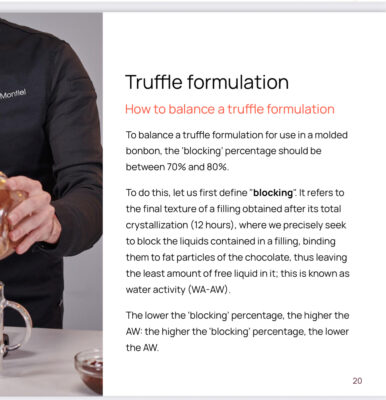Scoolinary › Forums › Ask a question › Mao montiel chocolate course
-
Mao montiel chocolate course
Posted by Alessandro Nirchio on August 9, 2025 at 13:14Hello to everyone,
I have a question about blocking water. Normaly is between 70/80% for each bonbon.
I would like to know how I calculate for enrobed pralines?
regards
Sussan Estela Olaya replied 3 months, 4 weeks ago 2 Members · 3 Replies -
3 Replies
-
Level:
Scoolinary Team
Hi Alessandro @alessandro-nirchio
When you ask what percentage the water blockage in chocolate making should be (whether “between 70 and 80%”), I understand you’re referring to how much the free moisture in the filling is reduced thanks to the coating. This “70–80% blockage” is, in this case, an indicative value that is typically achieved when the coating acts as an effective barrier against moisture migration from the filling.
This is not exactly a percentage measured in the same way as in a recipe’s ingredients, but rather the result of the barrier created by the chocolate or outer coating.
To calculate it in coated pralines, you can follow these steps:
-
Measure or determine the water activity (WA) of the filling on its own.
Example: your praline without coating has WA = 0.60 -
Measure or estimate the WA after coating it and letting it stabilize (for several hours or a day).
Example: the same praline, coated in chocolate, drops to WA = 0.40 -
Subtract the final WA from the initial WA, divide that result by the initial WA, and multiply by 100.
Example:
(0.60 – 0.40) / 0.60 x 100 = 33% blockage
This value tells you how much the coating blocks moisture migration. If that blockage percentage allows you to keep the final WA of the chocolate below the safe zone (generally under 0.65), then your product is stable.
Note: In Lesson 17 https://www.scoolinary.com/courses/chocolate-bonbon-formulation/lessons/measuring-devices of the course, Chef Mao Montiel explains the devices used to measure water activity and how to use them to better stabilize fillings. It’s worth reviewing to take these measurements more accurately.
According to what I saw in Chapter 16 of the course, the “70–80% blockage” is not calculated as a fixed number; rather, the WA is measured before and after coating, and you see how much it has dropped. The coating acts like a waterproof layer: the better the temper and the more uniform the coating, the more it reduces water migration.
I hope this information is helpful. If these values (70–80%) are mentioned in the course, please let me know the exact lesson where they appear so I can confirm. If there’s anything to add to my answer, I’ll let you know.
If you have any other questions about the courses or the platform, I’m happy to help.
Best regards,
Sussan Scoolinary Team-
Hello Susaan
thank you for your reply:
As you can see in this screenshot, the percentage of blocking, change the structure and texture of our bonbon. And in this case, the teacher is talking about moulded bonbon.
Indeed my question is, if I want to rich the right texture for a enrobed bonbon, how I have to work on formulation?
-
Level:
Scoolinary Team
Hi Alessandro @alessandro-nirchio
Thank you very much for letting me know where in the course the reference to the 70–80% blocking was. Now I have the context: in the lesson you shared, Chef Mao Montiel specifically mentions this range for molded bonbons and how this percentage influences the final texture and structure of the filling.
In the case of enrobed bonbons, the principle is the same (controlling water migration to achieve the desired texture and shelf life), but there are some important differences:
1. Key difference between molded and enrobed
-
Molded bonbon: the filling is surrounded by a uniform, sealed layer of chocolate, which allows for higher blocking percentages (70–80%).
-
Enrobed bonbon: the coating is applied by dipping and, although it also acts as a barrier, it may not be as uniform as in molded bonbons. This means the actual blocking percentage may be slightly lower.
2. How to work the formulation for enrobing
-
Adjust the filling recipe: to compensate for the potentially lower barrier effect of enrobing, you can reduce the free water content in the initial formulation. This is done by increasing dry solids (sugars, ground nuts, cocoa powder) or increasing the fat content.
-
Measure WA before and after enrobing: just like in your molded example, measure the water activity of the filling alone and then after it has been enrobed and stabilized. The blocking percentage is calculated as follows:
% Blocking = (Initial WA – Final WA) / Initial WA x 100
Example:
Initial WA of the filling = 0.60
Final WA after enrobing = 0.42
% Blocking = (0.60 – 0.42) / 0.60 x 100 = 30% -
Goal: even if you don’t reach 80%, the important thing is to keep the final WA below 0.65 to ensure microbiological stability.
3. Factors that help improve blocking in enrobed bonbons
-
Well-tempered coating with uniform thickness.
-
Controlled cooling to avoid microcracks.
-
Additional sealing on the base if possible (double dip or spot sealing).
I hope this time the information is clear. If you have more questions or doubts, I’m here to help.
-
-
-
The forum ‘Ask a question’ is closed to new discussions and replies.



